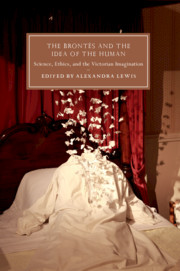Book contents
- The Brontës and the Idea of the Human
- Cambridge Studies in Nineteenth-Century Literature and Culture
- The Brontës and the Idea of the Human
- Copyright page
- Contents
- Figures
- Contributors
- Abbreviations
- Introduction Human Subjects
- Chapter 1 Hanging, Crushing, and Shooting
- Chapter 2 Learning to Imagine
- Chapter 3 Charlotte Brontë and the Science of the Imagination
- Chapter 4 Being Human
- Chapter 5 Charlotte Brontë and the Listening Reader
- Chapter 6 Burning Art and Political Resistance
- Chapter 7 Degraded Nature
- Chapter 8 ‘Angels … Recognize Our Innocence’
- Chapter 9 ‘A Strange Change Approaching’
- Chapter 10 ‘Surely Some Oracle Has Been with Me’
- Chapter 11 Jane Eyre, A Teaching Experiment
- Chapter 12 Fiction as Critique
- Chapter 13 We Are Three Sisters
- Bibliography
- Index
- Cambridge Studies in Nineteenth-Century Literature and Culture
Chapter 3 - Charlotte Brontë and the Science of the Imagination
Published online by Cambridge University Press: 22 May 2019
- The Brontës and the Idea of the Human
- Cambridge Studies in Nineteenth-Century Literature and Culture
- The Brontës and the Idea of the Human
- Copyright page
- Contents
- Figures
- Contributors
- Abbreviations
- Introduction Human Subjects
- Chapter 1 Hanging, Crushing, and Shooting
- Chapter 2 Learning to Imagine
- Chapter 3 Charlotte Brontë and the Science of the Imagination
- Chapter 4 Being Human
- Chapter 5 Charlotte Brontë and the Listening Reader
- Chapter 6 Burning Art and Political Resistance
- Chapter 7 Degraded Nature
- Chapter 8 ‘Angels … Recognize Our Innocence’
- Chapter 9 ‘A Strange Change Approaching’
- Chapter 10 ‘Surely Some Oracle Has Been with Me’
- Chapter 11 Jane Eyre, A Teaching Experiment
- Chapter 12 Fiction as Critique
- Chapter 13 We Are Three Sisters
- Bibliography
- Index
- Cambridge Studies in Nineteenth-Century Literature and Culture
Summary
Janis McLarren Caldwell compares Charlotte Brontë’s writing about experiences of imaginative transport (in the Roe Head Journal, which sustained engagement with the Angria of her earlier juvenilia, and in Jane Eyre) with Victorian scientific writing about the imagination. The work of early psychologists increasingly described creative imagination not as Romantic transcendence, but as a function of the automatic mind. For Caldwell, the discontinuity experienced by Brontë between creative unconscious and conscious states may be related to her frequent mature pattern of presenting Romantic interludes only to ironise or deflate them. Caldwell shows how Brontë’s early writings reserved her most exalted language for the experiences of imagining. Drawing upon Elaine Scarry’s notion of vivacity, Caldwell explores how Brontë’s work is placed in relation to pictorialist accounts of mental imaging. Charlotte Brontë, while influenced by materialist thought, rejected the wholesale erasure of the soul. While Brontë was attuned to ideas about embodiment and scientific accounts of the mind, she also employed a Scriptural language of body and soul. As Caldwell’s chapter shows, Charlotte Brontë’s introspective accounts of creativity are valuable for our contemporary neurological understandings of verbal and visual cognition, and continued Western philosophical investigations of the mind/body problem.
- Type
- Chapter
- Information
- The Brontës and the Idea of the HumanScience, Ethics, and the Victorian Imagination, pp. 67 - 83Publisher: Cambridge University PressPrint publication year: 2019

